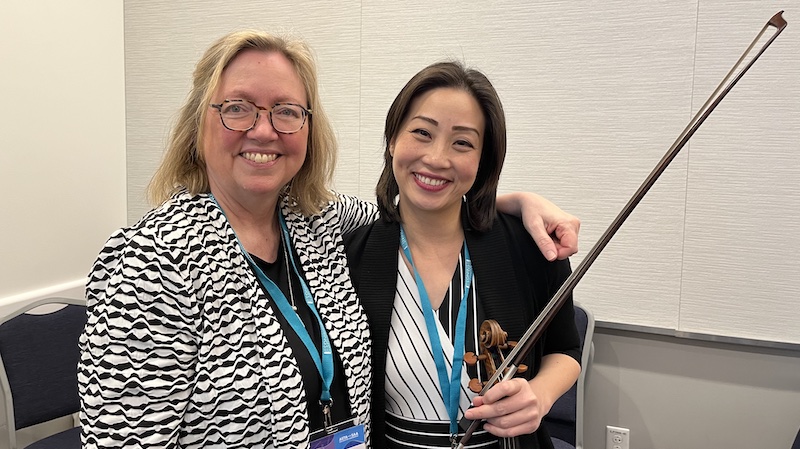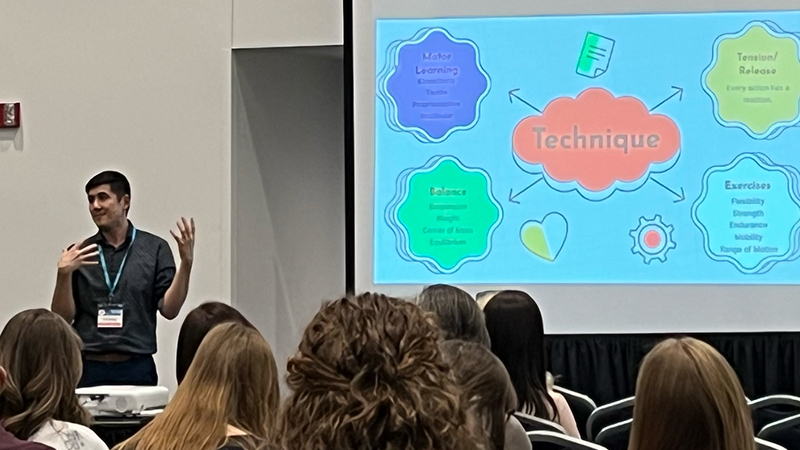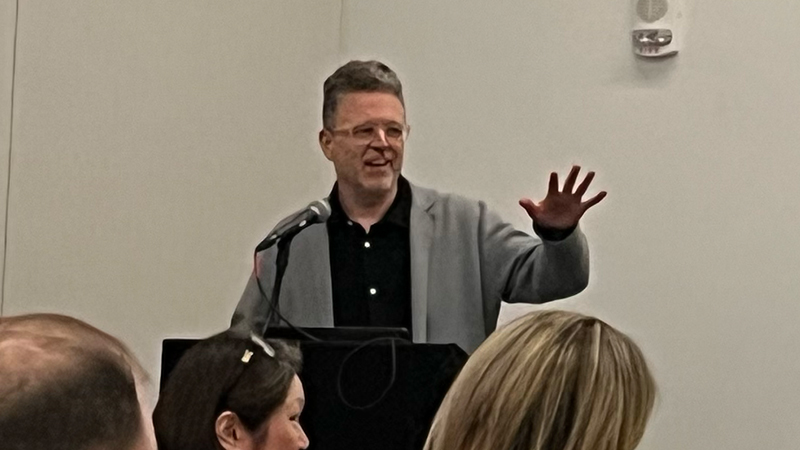A Deep Dive into Left Hand Technique at the 2024 ASTA/SAA Conference
One of the things I adore about attending conferences is the opportunity to get several different perspectives on similar pedagogical topics in a short amount of time. On the first full day of the conference, Thursday, I found myself in three different sessions on left hand technique. Here are some of my main takeaways from each!
1. Shifting from the Ground Up: Creative Approaches to Shifting With Ease, presented by Rebecca Henry (Peabody Institute) and Ching-Yi Lin (Western Kentucky University).

Rebecca Henry and Ching-Yi Lin.
I studied pedagogy with Rebecca Henry during my graduate studies at Peabody, so this session was more of a refresher course for me than a new approach, but it was fantastic. In addition to informative slides and live demonstrations with a student, the presenters had a detailed outline of their shifting method. It was thorough, detailed, and went through every step needed to go from not shifting to shifting successfully. I was affirmed by hearing several things that I do in my own teaching - and also realized some of the steps I need to do slightly differently with some students or spend more time on.
Henry and Lin shared that one of the most important aspects of developing a shifting technique is starting to build the physical motions from Day 1 of violin or viola studies. They pointed out that teaching the motion separate from the need to play in tune or play in a position in a certain amount of time is essential for creating a free and easy technique. For beginner students, they do exercises that involve sliding up and down the neck of the instrument in rest position, and tapping over the "high dot" (a sticker placed on the octave harmonic) in both rest and playing position.
Some other early shifting exercises they shared included finding the half-string octave harmonic, going between it and first position, and finding first and second fingers in third position as 4ths and 5ths. I also really enjoyed seeing demonstrations and videos of exercises that included alternating playing regular notes in first position and then shifting up to harmonics in a sort of improvisation - another great way to connect students to shifting as a creative motion and not as a stressful thing.
When shifting to higher positions, the presenters stressed the importance of coordinating the motion as the player comes around the shoulder of the violin - both swinging the arm under and bringing the thumb into the curve of the neck. How much they come under depends on the size of the hand and the length of the thumb, so this will vary, but they shared several exercises both for isolating this motion as well as stitching it together into one seamless shift from first position up to seventh and beyond.
There was so much information packed into this session (and so many people packed into a relatively small presentation room) that I left feeling slightly overwhelmed, but empowered to go home and continue working on shifting both in my own playing and with my students.
2. Why Can’t C-Natural FEEL Natural? Rebalancing the Left Hand presented by Daniel Gee Cordova

I wasn’t quite sure what to expect when attending this session, as Daniel Gee Cordova was someone who is new to me. I was delighted to discover his approach to left hand balance, and really enjoyed his engaging way of connecting with the audience.
Cordova described the process of balancing the left hand in this way:
- Find the center of balance in the hand through carefully chosen structural fingers - hint: it’s not ALWAYS the same finger(s)!
- Align the thumb/wrist and arm system through motion to experience weight and suspension.
- Add the rest of the fingers, adjusting for intonation and individual hand shape.
For me, the crucial change is the fact that the structural fingers change depending on the hand pattern. Early in my playing, I overbalanced to my first finger (a common mistake), and was taught to correct it by balancing to the 3 or the 4.
While balancing to the 3 is correct for a traditional 1 - high 2- 3 -4 pattern, for a pattern with low 2, the balance is shared between 1 and 3. With a high 3 added in, the 2 is the center of balance. And for a low 1 pattern where there are all whole steps between the hand, 2 and 3 share the balance. It’s also essential to constantly check in with the feeling of having the entire arm system balanced so that there is no extra tension or "holding" creeping in anywhere.
Cordova had started the session by explaining that the majority of the techniques he shared in the presentation were ones that he had worked out with a student of his who had really struggled with playing in-tune and with tension. A really sweet video of the student (now in college studying viola!) was part of the presentation, and it was wonderful to hear about their direct experience in improving their playing.
As if two powerhouse presentations on left hand technique weren’t enough, in true conference fashion, there was still more to come. I somehow found room in my brain to absorb one more session on this topic.
3. Mastering the Violin Fingerboard: Playing in Position and Shifting presented by Edmund Sprunger

Edmund Sprunger.
This was a packed session, with standing-room only at the back. It’s not surprising, considering that Sprunger is not only a Suzuki teacher trainer, but also the author of Helping Parents Practice and Building Violin Skills. It was also fun to see some of the earlier presenters in attendance at this session - another thing I love about attending conferences is how many teachers both share their expertise and then turn right around and are ready to learn from the other teachers. It makes for a wonderful atmosphere of collegiality. There’s not many places in the world where spontaneous applause breaks out in the middle of a talk on violin shifting technique, but the ASTA/SAA Conference is one of them.
Sprunger took us through his shifting philosophy and different exercises that he uses, starting by crossing out the word "Mastering" from the presentation title and replacing it with "opening up."
He started by asking, "What makes a good shift?" His answers: Knowing where you’re going, and having a shift that glides and hits the target. He further made the point that playing in position is NOT shifting - they are two different skills and need to be taught and trained as such. I thought this was an incredibly important point. So often shifting is taught as the means to an end - getting to the note in a different position - and the technique of shifting itself can be neglected or skimmed over as we focus on playing in tune.
He talked about the importance of preparing shifting motions early, and giving the students a positive experience of learning them. "It’s not the smart things you say, it’s the environment you create for them to learn in," he said about teaching. That one is going to stay with me. It’s a great question for us all to ask, whether we’re teaching others regularly, or even just working with ourselves in the practice room. What environment are we creating to learn in?
Like Henry and Lin earlier, he emphasized the importance of the shifting motion in the arm, saying that "Shifting happens underneath the violin." To demonstrate this motion, he had us swing our arms back and forth, then touch our noses with our little fingers. He mentioned that he also does this exercise with his students, sometimes with the violin in place (with the teacher stabilizing it) so they could experience a freely swinging left arm.
He also went through several shifting exercises using harmonics - my favorite was one in which he played Tonalization from the Suzuki books, but replaced all the 3rd fingers with 3rd finger natural harmonics. He also highlighted different Suzuki pieces where harmonics could be added in to give students practice shifting during pieces.
One other thing that intrigued me in his session was his use of a diagram of the fingerboard and colored plastic game pieces to both show finger patterns and note names in a visual way for students. It’s something I haven’t done before, but I definitely want to try it and see if it helps my students learn their patterns and notes in position more successfully.
There was far too much information in each session to put it all into one blog post, but these are a few of my main takeaways! And, these were just three sessions out of several that I attended at the conference. It was fascinating to get these different perspectives on left hand technique, all in the same day! I was reminded of the step-by-step process I use to teach shifting (review is always helpful!), got some new insights on releasing tension in the left hand by changing balance, and some great ideas for incorporating shifting exercises into the Suzuki Tonalization exercises and repertoire.
You might also like:
- Vijay Gupta at ASTA/SAA 2024: Music as a Place of Possibility
- Violin Lessons: Engaging the Adult Learner, with Megan Healy at ASTA 2023
- Past and Present ASTA Conference Coverage
* * *
Enjoying Violinist.com? Click here to sign up for our free, bi-weekly email newsletter. And if you've already signed up, please invite your friends! Thank you.
Tweet
Replies
This article has been archived and is no longer accepting comments.
Violinist.com is made possible by...
International Violin Competition of Indianapolis
Dimitri Musafia, Master Maker of Violin and Viola Cases
Johnson String Instrument/Carriage House Violins
Subscribe
Laurie's Books
Discover the best of Violinist.com in these collections of editor Laurie Niles' exclusive interviews.

Violinist.com Interviews Volume 1, with introduction by Hilary Hahn

Violinist.com Interviews Volume 2, with introduction by Rachel Barton Pine








April 7, 2024 at 10:54 PM · Thanks for writing this! I missed the first two of the presentations at the conference and was disappointed. Happy to get a taste of them here!